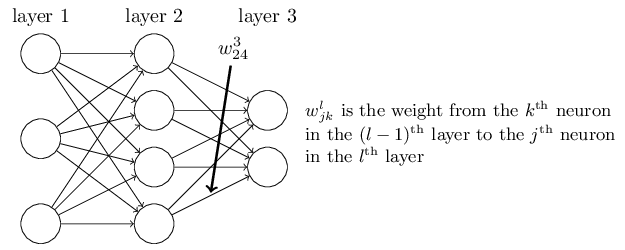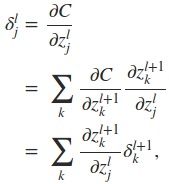BP网络中的反向传播
本文的主要参考:How the backpropagation algorithm works
下面是BP网络的参数结构示意图

首先定义第l层网络第j个神经元的输出(activation)

为了表示简便,令

则有alj=σ(zlj),其中σ是激活函数
定义网络的cost function,其中的n是训练样本的个数。

下面主要介绍使用反向传播来求取cost function相对于权重wij和偏置项bij的导数。
显然,当输入已知时,cost function只是权值w和偏置项b的函数。这里为了方便推倒,首先计算出∂C/∂zlj,令

由于alj=σ(zlj),所以显然有

式中的L表示最后一层网络,即输出层。如果只考虑一个训练样本,则cost function可表示为

如果将输出层的所有输出看成一个列向量,则δjL可以写成下式,Θ表示向量的点乘

下面最关键的问题来了,如何同过δl+1求取δl。这里就用到了∂C/∂zlj这一重要的中间表达,推倒过程如下



因此,最终有

写成向量的形式为

利用与上面类似的推倒,可以得到


将上面重要的公式用矩阵乘法形式再表达一遍




式中Σ'(zL)是主对角线上的元素为σ'(zLj)的对角矩阵。求取了cost function相对于权重wij和偏置项bij的导数之后,便可以使用一些基于梯度的优化算法对网络的权值进行更新。下面是一个2输入2输出的一个BP网络的代码示例,实现的是对输入的每个元素进行逻辑取反操作。
import numpy as np def tanh(x):
return np.tanh(x) def tanh_prime(x):
x = np.tanh(x)
return 1.0 - x ** 2 class Network(object): def __init__(self, sizes):
self.num_layers = len(sizes)
self.sizes = sizes
# self.biases is a column vector
# self.weights' structure is the same as in the book: http://neuralnetworksanddeeplearning.com/chap2.html
self.biases = [np.random.randn(y, 1) for y in sizes[1:]]
self.weights = [np.random.randn(y, x)
for x, y in zip(sizes[:-1], sizes[1:])] def feedforward(self, a):
"""Return the output of the network if "a" is input."""
for b, w in zip(self.biases, self.weights):
a = sigmoid(np.dot(w, a) + b)
return a def update_mini_batch(self, mini_batch, learning_rate = 0.2):
"""Update the network's weights and biases by applying
gradient descent using backpropagation to a single mini batch.
The "mini_batch" is a list of tuples "(x, y)"."""
nabla_b = [np.zeros(b.shape) for b in self.biases]
nabla_w = [np.zeros(w.shape) for w in self.weights] # delta_nabla_b is dC/db, delta_nabla_w is dC/dw
for x, y in mini_batch:
delta_nabla_b, delta_nabla_w = self.backprop(x, y)
nabla_b = [nb + dnb for nb, dnb in zip(nabla_b, delta_nabla_b)]
nabla_w = [nw + dnw for nw, dnw in zip(nabla_w, delta_nabla_w)]
self.weights = [w - (learning_rate/len(mini_batch)) * nw
for w, nw in zip(self.weights, nabla_w)]
self.biases = [b - (learning_rate/len(mini_batch)) * nb
for b, nb in zip(self.biases, nabla_b)] def backprop(self, x, y):
"""Return a tuple ``(nabla_b, nabla_w)`` representing the
gradient for the cost function C_x. ``nabla_b`` and
``nabla_w`` are layer-by-layer lists of numpy arrays, similar
to ``self.biases`` and ``self.weights``."""
nabla_b = [np.zeros(b.shape) for b in self.biases]
nabla_w = [np.zeros(w.shape) for w in self.weights] # feedforward
activation = x
activations = [x] # list to store all the activations, layer by layer
zs = [] # list to store all the z vectors, layer by layer # After this loop, activations = [a0, a1, ..., aL], zs = [z1, z2, ..., zL]
for b, w in zip(self.biases, self.weights):
z = np.dot(w, activation) + b
zs.append(z)
activation = sigmoid(z)
activations.append(activation) # backward pass
# delta = deltaL .* sigma'(zL)
delta = self.cost_derivative(activations[-1], y) * \
sigmoid_prime(zs[-1]) # dC/dbL = delta
# dC/dwL = deltaL * a(L-1)^T
nabla_b[-1] = delta
nabla_w[-1] = np.dot(delta, activations[-2].transpose()) '''Note that the variable l in the loop below is used a little
differently to the notation in Chapter 2 of the book. Here,
l = 1 means the last layer of neurons, l = 2 is the
second-last layer, and so on. It's a renumbering of the
scheme in the book, used here to take advantage of the fact
that Python can use negative indices in lists.'''
# z = z(L-l+1), here, l start from 2, end with self.num_layers-1, namely, L-1
# delta = delta(L-l+1) = w(L-l+2)^T * delta(L-l+2) .* z(L-l+1)
# nabla_b[L-l+1] = delta(L-l+1)
# nabla_w[L-l+1] = delta(L-l+1) * a(L-l)^T
for l in xrange(2, self.num_layers):
z = zs[-l]
sp = sigmoid_prime(z)
delta = np.dot(self.weights[-l + 1].transpose(), delta) * sp
nabla_b[-l] = delta
nabla_w[-l] = np.dot(delta, activations[-l - 1].transpose())
return (nabla_b, nabla_w) def evaluate(self, test_data):
"""Return the number of test inputs for which the neural
network outputs the correct result. Note that the neural
network's output is assumed to be the index of whichever
neuron in the final layer has the highest activation."""
test_results = self.feedforward(test_data)
return test_results def cost_derivative(self, output_activations, y):
return (output_activations - y) #### Miscellaneous functions
def sigmoid(z):
return 1.0/(1.0 + np.exp(-z)) # derivative of the sigmoid function
def sigmoid_prime(z):
return sigmoid(z) * (1 - sigmoid(z)) if __name__ == '__main__': nn = Network([2, 2, 2]) X = np.array([[0, 0],
[0, 1],
[1, 0],
[1, 1]]) y = np.array([[1, 1],
[1, 0],
[0, 1],
[0, 0]]) for k in range(40000):
if k % 10000 == 0:
print 'epochs:', k
# Randomly select a sample.
i = np.random.randint(X.shape[0])
nn.update_mini_batch(zip([np.atleast_2d(X[i]).T], [np.atleast_2d(y[i]).T])) for e in X:
print(e, nn.evaluate(np.atleast_2d(e).T))
运行结果
epochs:
epochs:
epochs:
epochs:
(array([, ]), array([[ 0.98389328],
[ 0.97490859]]))
(array([, ]), array([[ 0.97694707],
[ 0.01646559]]))
(array([, ]), array([[ 0.03149928],
[ 0.97737158]]))
(array([, ]), array([[ 0.01347963],
[ 0.02383405]]))
BP网络中的反向传播的更多相关文章
- 神经网络中的反向传播法--bp【转载】
from: 作者:Charlotte77 出处:http://www.cnblogs.com/charlotte77/ 一文弄懂神经网络中的反向传播法——BackPropagation 最近在看深度学 ...
- 一文弄懂神经网络中的反向传播法——BackPropagation【转】
本文转载自:https://www.cnblogs.com/charlotte77/p/5629865.html 一文弄懂神经网络中的反向传播法——BackPropagation 最近在看深度学习 ...
- 一文弄懂神经网络中的反向传播法——BackPropagation
最近在看深度学习的东西,一开始看的吴恩达的UFLDL教程,有中文版就直接看了,后来发现有些地方总是不是很明确,又去看英文版,然后又找了些资料看,才发现,中文版的译者在翻译的时候会对省略的公式推导过程进 ...
- [转] 一文弄懂神经网络中的反向传播法——BackPropagation
在看CNN和RNN的相关算法TF实现,总感觉有些细枝末节理解不到位,浮在表面.那么就一点点扣细节吧. 这个作者讲方向传播也是没谁了,666- 原文地址:https://www.cnblogs.com/ ...
- PyTorch中在反向传播前为什么要手动将梯度清零?
对于torch中训练时,反向传播前将梯度手动清零的理解 简单的理由是因为PyTorch默认会对梯度进行累加.至于为什么PyTorch有这样的特点,在网上找到的解释是说由于PyTorch的动态图和aut ...
- 一文弄懂神经网络中的反向传播法(Backpropagation algorithm)
最近在看深度学习的东西,一开始看的吴恩达的UFLDL教程,有中文版就直接看了,后来发现有些地方总是不是很明确,又去看英文版,然后又找了些资料看,才发现,中文版的译者在翻译的时候会对省略的公式推导过程进 ...
- 【机器学习】反向传播算法 BP
知识回顾 1:首先引入一些便于稍后讨论的新标记方法: 假设神经网络的训练样本有m个,每个包含一组输入x和一组输出信号y,L表示神经网络的层数,S表示每层输入的神经元的个数,SL代表最后一层中处理的单元 ...
- 反向传播(BP)算法理解以及Python实现
全文参考<机器学习>-周志华中的5.3节-误差逆传播算法:整体思路一致,叙述方式有所不同: 使用如上图所示的三层网络来讲述反向传播算法: 首先需要明确一些概念, 假设数据集\(X=\{x^ ...
- 神经网络之反向传播算法(BP)公式推导(超详细)
反向传播算法详细推导 反向传播(英语:Backpropagation,缩写为BP)是"误差反向传播"的简称,是一种与最优化方法(如梯度下降法)结合使用的,用来训练人工神经网络的常见 ...
随机推荐
- Codeforces Round #349 (Div. 2) D. World Tour 暴力最短路
D. World Tour A famous sculptor Cicasso goes to a world tour! Well, it is not actually a world-wid ...
- POJ3190 Stall Reservations 贪心
这是个典型的线程服务区间模型.一些程序要在一段时间区间上使用一段线程运行,问至少要使用多少线程来为这些程序服务? 把所有程序以左端点为第一关键字,右端点为第二关键字从小到大排序.从左向右扫描.处理当前 ...
- hdoj--1281--棋盘游戏(最小点覆盖+枚举)
棋盘游戏 Time Limit: 2000/1000 MS (Java/Others) Memory Limit: 65536/32768 K (Java/Others) Total Submi ...
- poj1028--动态规划--Ignatius and the Princess III
Ignatius and the Princess III Time Limit: 2000/1000 MS (Java/Others) Memory Limit: 65536/32768 K ...
- python笔记:字符编码
ASCII编码 知识点:计算机中最小的单位是bit,bit就咱们常说一位二进制,一位二进制要么是0 要么是 1.但是bit这个单位太小了,我们用字节(byte)来表示.换算的规则如下: 8b = 1B ...
- 关于KO信息
最近写大论文查到KO也是可以用于分类的一种信息. 如何使用KEGG进行通路富集http://blog.sciencenet.cn/blog-364884-779116.html kegg 数据库学习笔 ...
- (转载) popupWindow 指定位置上的显示
popupWindow 指定位置上的显示 标签: androidpopupWindowpopupWindow具体位置放置 2014-07-09 16:23 1114人阅读 评论(0) 收藏 举报 分 ...
- Java数组操作工具
原文地址:http://blog.csdn.net/qq446282412/article/details/8913690 2013-05-11 10:27 看到网上的一段关于对数组操作的代码,觉 ...
- Asp.net Core 源码-PagedList<T>
using System.Collections.Generic; using System.Linq; using System; using System.Linq.Expressions; us ...
- Pyhton学习——Day1
1.什么是机器码?什么是字节码?机器码(machine code),学名机器语言指令,有时也被称为原生码(Native Code),是电脑的CPU可直接解读的数据. 通常意义上来理解的话,机器码就是计 ...
